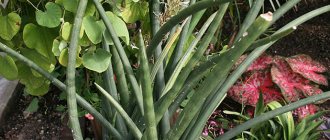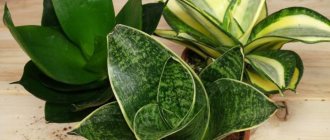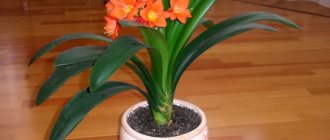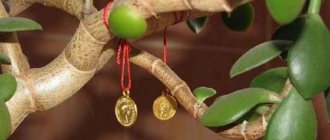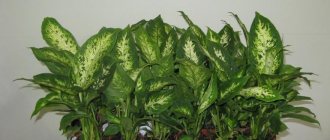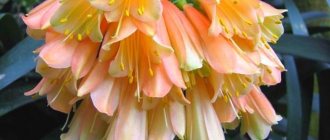Sansevieria, or colloquially “mother-in-law’s tongue”, “pike tail” does not require special care at home, but it is one of the main sources of oxygen. Transplanting and propagating Sansevieria is very simple and even novice gardeners can do it. This houseplant is a perennial with long leaves that grow from the root upward. The length of the sheet can reach up to 1 meter. There are about 10 types of Sansevieria, they are popular both in the home and in offices due to their unpretentiousness.
Sansevieria care at home with photo demonstration
You need to take a thick-walled ceramic pot for sansevieria, since the powerful roots of the flower can break the walls, taking up space. Young plants are replanted every one and a half years, then every three years. In large tubs and boxes, only the top layer of soil is changed. Often, replanting sansevieria in the spring is accompanied by dividing the bush. The composition of the soil is simple, it is collected independently from volume fractions:
- leaf soil;
- peat;
- sand;
- humus.
Take the ingredients in equal parts and add two parts of turf soil. The drainage layer can also be made of expanded clay balls or pieces of foam.
If Sansevieria blooms in the house, it’s time to fulfill a long-planned undertaking. A flowering plant blesses a new business, it will be successful. Winter flowering of sansevieria is not a harbinger of good luck.
Watering when caring for sansevieria is carried out with rain or soft, settled water. The plant does not require frequent and abundant moisture. Water as the soil dries, rarely in winter. Sansevieria is fed twice a summer with a predominance of potassium-phosphorus fertilizers. Excess nitrogen can cause root rot and loss of decorative properties.
Lighting when caring for Sansevieria at home affects the contrast of the patterned stripes on the leaves. With a lack of light, the leaves become dull; with too much light, they turn yellow. Winter supplementary lighting is mandatory to maintain the beauty of the mother-in-law's tongue.
The flower feels good at temperatures above 14 degrees. He, like all people from the tropics, is harmed by drafts and sudden changes in temperature. If the content is close to natural, you can wait for flowering, accompanied by a subtle aroma of vanilla.
Problems in caring for Sansevieria at home arise due to violation of the conditions of detention:
- If light areas appear on the leaves, you need to reduce the illumination and ambient temperature.
- Appearing areas of rotting leaves signal waterlogging of the soil. Cut out damaged areas, treat wounds, reduce watering.
- The leaves stretch out and droop - there is not enough light.
- The tips turn yellow and dry - it’s cold, excessive watering, not enough light.
- Invaded spider mites are difficult to detect at first. But the leaf turns pale, the plant is depressed. It is useful to wipe the sheets with a damp cloth; the tick will not start.
- Once infested thrips can be removed with insecticides, mealybugs can be removed with karbofos.
Sansevieria transplant
There is no need to replant sansevieria often; once every two to three years is enough. Low, but wide and deep pots are suitable for this plant, since the roots grow wide. Replanting is recommended when the roots begin to emerge from the soil.
Important!
Sansevieria roots love close quarters and if replanted, the pot should be no more than 10% larger than the previous one.
Sansevieria propagation
Reproduction of mother-in-law's tongue occurs by seed, division of rhizomes and cuttings of leaf blades.
After flowering, pods are formed in which pea seeds are filled and ripen. They are stored until sowing in a closed pod, each seed is placed in a separate cup. Germination is carried out in warmth.
When transplanting, rhizomes are disassembled and a part of the bush or cuttings with roots is separated with a sharp knife. In this case, open sections must be disinfected so as not to cause rot in the future. When planting, you need to take into account that powerful roots, growing, can break or deform the pot.
Sansevieria leaves are often used for propagation. An adult healthy “tongue”, usually the lower one, is selected and cut to the base. Reproduction by Sansevieria leaf allows you to obtain several new specimens.
The sheet, cut into fragments of 5-10 cm, is dried for two days. It is necessary at the very beginning to mark the cut that will take root in the ground. It is important to take into account the direction of movement of the juices.
Sansevierias that grow in a spiral pattern can be shaped. If a growing leaf is pinned and placed in a horizontal position for a long period, it will remain in this position.
When propagating sansevieria by leaf, the plates are deepened into the ground by 2 cm. A mini-greenhouse is organized on top, which is ventilated once a day. The container should be kept warm and in the light.
How to propagate sansevieria
Reproduction of sansevieria, in contrast to care, is a rather complex process. Young plants can be obtained by cuttings, dividing rhizomes or suckers, or sowing seeds.
You can only get seeds by collecting them from your plant. They are not sold in flower shops. Sow immediately after collection in damp sand. The container is placed in a greenhouse; if additional moisture is needed, water through a tray. The seedlings hatch within a few months, after which they are planted (planted in separate containers when they reach 8 cm).
Propagation of Sansevieria by leaves is used only for monochromatic species - variegation is not transmitted in this way. For cuttings, a healthy leaf is selected from the middle of the rosette, cut into segments of 5-6 cm. The pieces are allowed to dry for an hour, after which the sections are generously sprinkled with crushed charcoal. The prepared material is planted in wet sand so that only one corner is buried. The container is placed in a greenhouse. It is desirable to have bottom heating; the temperature should not fall below 25 degrees. Water rarely, so that the leaf cuttings do not rot, through a tray. Roots appear in a month and a half.
All varietal characteristics are preserved only when dividing the rhizome or propagating by offspring. These methods are used in the spring, during transplantation. In the first case, the rhizome is cut with a sharp knife so that each part has a growing point. In the second, the lateral processes are separated, trying to preserve as many roots as possible on them. The resulting material is placed in pots and shed generously; There is no need to put it in a greenhouse. Delenki take root faster in the warmth.
Sansevieria at home, types
Author: Natalya February 21, 2022 Category: Houseplants
Not many gardeners know that Sansevieria loves to spend its summer holidays outdoors. But in vain! After all, for such a “vacation”, a plant with a bunch of the most formidable names will almost certainly thank you with a modest, but so vanilla-fragrant flowering! How to arrange everything? With the onset of stable spring warmth, a pot of sansevieria can be placed on a balcony or veranda, but it is even better to transplant the “tongue of Satan” into open ground. The main thing is not to forget to take the rested and strengthened sansevieria home in September. Interesting fact: at home, Sansevieria most often blooms when... its pot becomes too small for it! After enjoying the long-awaited flowering, do not forget to replant the flower. How to do this correctly, as well as about the nuances and possible problems in growing sansevieria, read in our article.
Transfer
Replanting pike tail at home is not difficult due to the fact that its root system is tolerant of invasions. Young plants are replanted annually in the spring, adults - once every 2-3 years. A signal to change the container is the appearance of roots from the drainage holes or the presence of a large number of shoots.
We recommend reading
How to care for Chlorophytum at home
Features of growing and caring for Gloxinia
Home care for Hibiscus
Caring for Sheflera at home
Choosing the right pot and soil
The shallow root system of Sansevieria requires a wide, low container. It is advisable to choose a dense and heavy pot: this way it will not tip over and burst under the pressure of powerful roots. The distance from the neck of the rosette to the sides should not exceed 4 cm.
The optimal soil for sansevieria consists of leaf, turf soil, sand and peat or coconut fiber in a ratio of 2:2:1:1. Some gardeners advise adding gravel to the mixture. You can purchase specialized soil for succulents at a flower shop.
Step-by-step transplant process
Sansevieria transplantation is carried out according to the following algorithm:
- the plant is removed from the old container;
- the roots are partially freed from the substrate and examined for the presence of rot;
- a small layer of drainage and fresh soil is poured into the new container;
- Having installed the flower and checking that the neck of the rosette is not buried under any circumstances, cover the roots with soil.
Planting and caring for sansevieria
- Flowering: decorative deciduous plant.
- Lighting: partial shade, bright diffused light.
- Temperature: normal for residential premises. In winter, not lower than 16˚C.
- Watering: regular, moderate, more frequent in summer than in winter.
- Humidity: normal for residential premises.
- Feeding: during the active growing season, once a month with a fertilizer solution for cacti or decorative foliage plants.
- Rest period: not clearly expressed.
- Repotting: when the pot becomes too small for the plant.
- Reproduction: vegetative (by rhizome division or leaf cuttings).
- Pests: mealybugs, thrips, spider mites.
- Diseases: anthracnose, root rot.
Sansevieria , or sansevieria , or sansevieria , is a genus of the Asparagus family (in some catalogs - Agaveceae), which includes more than 60 species of evergreen perennial stemless plants from the rocky, dry regions of the tropics and subtropics of Africa, Madagascar, South Florida, Indonesia and India. This unpretentious and therefore popular indoor plant in different countries has received the nicknames “pike tail”, “snake skin”, “mother-in-law’s tongue”. Its value is that it is indestructible: you can forget about it for a week or two, and it will not die or dry out. In addition, the Sansevieria plant is happily used by designers to create flower arrangements and decorate interiors.
Short description
Sansevieria is an evergreen herbaceous perennial belonging to the Agave family. The houseplant pike tail came to us from Africa and other tropical and subtropical regions, which explains its drought resistance. In nature, it settles on dry rocky soils.
The leaves are erect, elongated, lanceolate, succulent. Form a dense symmetrical rosette. The flowers are small, white or cream, collected in racemes. They produce nectar with a delicate and subtle vanilla aroma. Its droplets flowing down the leaves gave rise to one of the popular names of this plant - mother-in-law's tears. In general, Sansevieria, perhaps due to its popularity and widespread distribution, has many “nicknames”: leopard lily, snake skin, pike tail, mother-in-law’s tongue and others.
Caring for Sansevieria at home
How to care for sansevieria
Any temperature is suitable for sansevieria, air humidity will also not particularly affect the growth and appearance of the plant, but still, if you want to see sansevieria in its best form, try to ensure that in winter the room temperature does not fall below 16 ºC, and the leaves of sansevieria It's a good idea to wash it from time to time.
Caring for sansevieria means, first of all, proper watering, but by experimenting with watering, you risk destroying the flower. Therefore, it is best to take advantage of such an achievement of civilization as a humidity indicator, which you can buy at a flower shop and which will remind you that it is time to water the flower. It is better to use rainwater, distilled water, or at least at room temperature for irrigation. In winter, the colder the room, the less often the sansevieria needs to be watered. Wash off the dust from the plant with a damp sponge.
Sansevieria transplant
You will not have to replant sansevieria often - young plants need replanting once every two years, mature ones - once every three. You can read about how to replant sansevieria on many websites, but not everywhere there is information about what soil mixture sansevieria prefers: it is better to buy soil for the plant at a flower shop, because soil from the garden will not suit it.
The composition of the soil should be approximately this: one part each of leaf soil and sand and two parts of turf soil. Store-bought soil also contains perlite or fine gravel.
Sansevieria is replanted only when the roots of the plant appear from the drain hole of the pot. Choose a thick-walled pot, preferably clay, so that the powerful root system of the plant does not tear it apart, and long, heavy leaves do not overturn the pot. The shape of the pot, due to the peculiarities of the development of the root system, should be wide rather than deep. And remember: the most important thing is a good drainage layer.
Sansevieria fertilizer
In the spring and summer, you can feed sansevieria monthly with liquid mineral fertilizers for indoor crops or cacti. Make sure that excess nitrogen does not damage the plant, and in general, try to keep the consistency two times weaker than recommended.
Top dressing
It is enough to feed Sansevieria with liquid fertilizer for cacti in the spring and summer once a month. To fertilize, dilute fertilizer in water in a ratio of 2:1, and for varieties with pronounced stripes, 3:1, otherwise, due to an excess of fertilizing, “mother-in-law’s tongue” may lose its color.
Advice!
For better flower growth, it is worth using soil consisting of leaf soil, turf soil and sand in proportions of 2:2:1.
Sansevieria propagation
Dividing Sansevieria rhizomes
Sansevieria is propagated by dividing the rhizome, lateral shoots and dividing the leaf. The most convenient way to divide the rhizome of a plant is during spring replanting: use a sharp knife to cut the rhizome so that a growing point remains on each part. Place the divided sansevieria in different pots and place them in a warm place. Water sparingly. This method is suitable for both monochromatic and variegated types of sansevieria.
Reproduction of Sansevieria by leaf division
Also a simple procedure. The old leaf is cut into pieces 4-5 cm long, dried a little in the air, then the lower end is immersed in sand at an angle of 45º, covered with a jar or cut-off plastic bottle and, with moderate bottom watering (water is poured into the tray of the pot), rooted.
After 30-40 days, as soon as the leaf takes root and produces buds from which young leaves appear, the plant is transplanted into a pot with soil. This method is suitable only for monochromatic species of sansevieria: even if you root a striped leaf, the baby will still grow green.
Properties of Sansevieria
Sansevieria contains many biologically active substances, but the most popular of them are saponins, which, when used correctly, bring significant benefits. Traditional medicine uses saponins to produce choleretic, anti-inflammatory, laxative and expectorant drugs. Traditional medicine treats cystitis, inflammation of the oral cavity, otitis, cuts and other skin injuries with sansevieria.
The foaming properties of saponins are used in the cosmetics industry in the production of liquid soap and shampoos. It is not recommended to use the plant for medicinal purposes by pregnant women, since the substances it contains have an abortifacient effect.
Types of Sansevieria
Sansevieria has a creeping rhizome with basal leaves, powerful and hard, reaching a height of 1 meter or more. The leaves come in varying shades of green and brown, and some have stripes or spots. The flowering of Sansevieria is not very attractive: white and green flowers, collected in cylindrical inflorescences, opening towards sunset, exude a subtle vanilla aroma. The fruit is a berry with several seeds, but in indoor conditions Sansevieria rarely bears fruit. The most famous types of Sansevieria:
Sansevieria grandis
Perennial, rosette of 2-4 succulent light green leaves 30-60 cm long and up to 15 cm wide. There are dark transverse stripes along the leaves, and along the edge there is a reddish border;
Sansevieria hyacinthoides
The plant is up to half a meter high, the leaves grow in bunches of 2-4 pieces, length from 14 cm to 45 cm, width up to 7 cm. The color of the leaves is dark green with light green W-shaped strokes, the edges of the leaves are reddish or whitish;
Sansevieria dooneri
An indistinct leaf succulent that forms rosettes containing up to 20 flat, erect leaves up to 40 cm long and up to 3 cm wide. The leaf color is green with a dark green pattern;
Sansevieria graceful (Sansevieria gracilis)
Or graceful Sansevieria - a perennial succulent: the leaves cover the base of the stem 5-6 cm high. The leaves are leathery, oval, long-pointed, gray-green in color with gray-beige transverse streaks;
Sansevieria kirkii
This plant has a short rhizome and rosettes with a small number of green leaves with whitish spots with a red-brown edge. There are varieties with brown or red-brown leaves;
Sansevieria liberica
An indistinct leaf succulent with unfolded rosettes of 6 flat leaves parallel to the ground. The length of the leaves sometimes reaches 100 cm in length and 8 cm in width, but this is only in very large specimens. The color of the leaves is dark green with blurry light green streaks and streaks, along the edge of the leaf there is a thin reddish-white or brown stripe.
Sansevieria trifasciata
But in indoor floriculture, the most common species is Sansevieria three-stripe - a tall plant with sword-bearing leaves of green or green color with a yellow border. Rosette Sansevieria trifasciata Hahnii with green or striped leaves is also a favorite among lovers. They are very beautiful and unpretentious, and besides, you already know how to care for sansevieria.
Types and varieties of Sansevieria
Despite the difference in species, Sansevieria is one of the most unpretentious and decorative indoor flowers. They are most often used by designers to create flower arrangements or interior decoration.
You may be interested in:
Choosing indoor plants for air purification Properly selected indoor plants can significantly improve the indoor microclimate. It is especially necessary...Read more...
Hanny
This low-growing and quite beautiful indoor plant was bred in 1941 from Sansevieria Laurenti by the famous breeder S. Khan. Hence the name. This rosette variety is no higher than 30 cm in height.
In 1953, Khan developed another variety with yellow stripes on the sides of the leaves - golden hunny. Unlike other types of “piketail”, this variety loves bright light, but note that in very sunny weather the plant must be applied. And in shady places, especially in winter, you need to add additional lighting. With the right light, the color appears brighter.
In summer, the temperature varies from 20 to 25°C, in spring and autumn from 18 to 20, and in winter and the rest period 15°C is the optimal temperature.
Three-lane Sansevieria
Sansevieria of this species is the most common, and the height of this plant at home ranges from a meter to 150 cm.
This type should be placed on light windows, with the exception of northern ones. The leaves of “mother-in-law’s tongue” are painted in a rich green color, and the edges have pale yellow shades. The leaf itself is covered with an unusual pattern, which adds beauty to the leaves.
Flowering occurs in spring or autumn: the flowers are small, very fragrant, light green. The soil for geraniums is quite suitable for planting and growing.
Cylindrical Sansevieria
The variety of this sansevieria is unlike other species with its elongated leaves. The name comes from the shape of the leaves: they are rounded along their entire length, so they resemble a cylinder.
This species was bred by breeders, so they cannot be seen in the natural environment. At home, if you properly care for the plant, it can reach a height of 130 to 150 cm. The flowers of Cylindrical Sansevieria are also not similar to other relatives. They vary from white to pink shades, appearing on a meter-long flower stalk.
Laurenti
This is the main variety of Sansevieria, from which breeders have developed many new species. Laurenti leaves grow upward and may have a yellow stripe along the edge of the leaf.
Zeylanika
The most popular type of “pike tail”, which is in great demand along with three-lane sansevieria. But this variety has its own distinctive features: the leaves of zeylanika are wide and covered with small spots, which have a silvery tint when the indoor plant reaches maturity. They also have a traditional pattern, but there is no white or yellow stripe along the edge; they are located along the entire length of the central part.
White sansevieria
Sensation Bantel or White Sansevieria - this species was bred in 1948 by breeder Gustav Bantel. This variety differs from others in its unusual coloring: the leaves have white longitudinal stripes alternating with dark green.
Due to the fact that white sansevieria grows quite slowly, it is therefore one of the rare species.
- Sansevieria Kirki;
- Sansevieria Pinguicula (“walking”);
- Sansevieria Stuckey;
- Sansevieria Francisi;
- Sansevieria Ehrenberg;
- Twisted Sister;
- Sansevieria Eulensis;
- Silver Queen.
You may be interested in:
How to care for geraniums in winter? Many women love to grow flowers at home, because it’s not only beautiful, but there’s something to do with their free time....Read more...
Why is Sansevieria transplanted and how to do it correctly?
Sansevieria is an evergreen stemless herbaceous succulent from the Asparagus family.
It is very decorative and unpretentious, and is also characterized by rapid growth, vitality and fertility, so the question of how to plant a houseplant regularly arises before its owner.
But in order for the plant to please with its beauty, you need to know everything not only about how to replant it, but also about the right time for this.
Why and when do you need to replant a pike tail?
Replanting Sansevieria at home is required approximately once a year, and the signal for this is usually the protrusion of roots from the pot or a large number of new shoots. And if the pot is plastic, it can simply burst under the pressure of a powerful root system. In this case, the owner has no choice but to transplant the plant into another pot.
Therefore, as soon as the plant declares that it needs attention, you should immediately acquire a new strong, thick-walled clay pot of small depth and at the same time wide enough. In addition, you will need purchased soil for succulents and good drainage.
Watering and air humidity
When caring for sansevieria at home, it is worth remembering that the plant should not be overwatered. That is, watering should be moderate and only after the earthen clod has dried. In summer, once every seven days is enough, and in winter - approximately once a month, but we must not forget that if the plant is standing next to the battery, then watering is done as the soil dries.
Important!
When watering the flower, make sure that water does not get into the center of the rosette, otherwise this may cause the sansevieria to rot.
This indoor plant normally tolerates dry air in apartments, and the dust that forms on the leaves can be wiped off with warm water.
What time of year should you do this and how often?
Usually, new shoots appear on sansevieria in the spring, but under especially favorable conditions for it, it can produce children all year round.
You can both replant and plant a flower at any time of the year; this will not harm its vitality in any way. On the contrary: having received a new spacious pot and space for the root system, she will happily begin to grow and reproduce. The plant does not have a dormant period, it enjoys life all year round on any windowsill and at any temperature above +15 o C, so if a flower asks to be replanted in winter, you should not refuse and postpone the matter until spring.
How to do this at home?
- First of all, you need to choose a container in which the flower will grow, purchase suitable soil, expanded clay and stock up on a knife to facilitate the process of removing it from the old pot. The blunt side of a knife is drawn inside along the wall of the pot to separate the soil from it, and the sansevieria is carefully pulled out.
- It is better to shake off the old soil or wash it off the roots in a basin of water.
- A layer of expanded clay is poured into the bottom of a new pot, the plant is installed and covered with earth.
- The soil is compacted and watered; if necessary, soil is added and compacted again.
Rules for placing plants in open ground
If the climate allows and at night the temperature outside never drops below +15 o C, you can decorate your garden with sansevieria. It is better to carry out this work in late spring or early summer.
The planting site should be well lit, but not exposed to direct sunlight.
- To do this, first prepare the soil. You can compose it yourself from the following components:
- peat;
- sand;
- leaf soil;
- humus.
Then holes about 15 cm deep are made in the soil into which new plants will be planted. Plant sections should already be treated with crushed activated carbon.- Drainage is added to the bottom of the holes - small stones, expanded clay, broken shards.
- Prepared soil is poured onto the drainage layer.
- Install young plants with a height of 20 cm and 5 leaves per bush.
- Add more soil, water a little and press down the soil until the plant is completely fixed.
How to properly transplant a pike tail
The long, sharp leaf-“tongue” of Sansevieria gave rise to comparison with a sarcastic mother-in-law, and its striped-green color with a pike’s tail.
Sansevieria itself , which naturally grows on the dry, rocky soils of the tropics of Africa, India and America, due to its hardiness and unpretentiousness, has a well-deserved reputation as an “unkillable” plant .
Even completely devoid of soil, just in a vessel with water, it persists for a long time and even grows.
However, the increased resistance of sansevieria is not a reason to deprive it of a convenient container and suitable soil.
Landing capacity
The root system of “mother-in-law’s tongue” develops slowly and is located shallowly.
Therefore, the container for planting should be chosen so that it is wide, but not deep , and matches the size of the plant.
Sansevieria will have difficulty mastering a planting capacity that is too large. Pots for mother-in-law's tongue are selected based on the following calculation: the height is half the diameter - for low varieties. For medium-sized and tall specimens, the height of the container can be equal to its diameter.
In addition, the bottom of the container must have drainage holes of sufficient size to ensure effective drainage of excess moisture.
Soil composition
For pike tail, it is better to choose moderately fertile, loose, slightly acidic .
From ready-made soils, a soil mixture for cacti and succulents , and for self-production - one of the following compositions:
- two parts of leaf soil, half of humus, one part of turf soil, peat and sand;
- one part turf, one part leaf soil, two parts coarse sand;
- three parts of turf land, one each of peat and sand.
You can also add perlite, vermiculite, brick chips, pieces of charcoal and a small amount of bone meal to the main types of soil for sansevieria.
Sometimes sansevieria is planted in compositions of ampelous and ground cover plants. In this case, so that the not too intensively growing “pike tail” can withstand competition with more aggressive species, a nutrient substrate of the following composition is suitable for it: three parts of turf soil and one part each of peat, coarse sand and compost.
Landing
When planting a pike tail flower, you should definitely take care of good drainage: expanded clay, broken bricks with pieces of charcoal, or small pebbles should be placed on the bottom of the planting container and fill up to a third of its volume (young plants especially need a thick drainage layer).
Sansevieria should be planted together with a lump of earth entwined with roots, so that the not very powerful root system of the succulent is less damaged.
Transfer
Young “pike tails” are replanted annually in the spring, in March-April . Mature specimens need more rare spring “relocations”, once every two to three years .
Despite this, the next container for planting is chosen only slightly larger than the previous one - the roots of the “pike tail” grow slowly and pathogenic processes can occur in the soil “undeveloped” by the plant.
As a rule, “mother-in-law’s tongues”, under more or less suitable conditions, grow well with rhizomes with new, young shoots.
Such rhizomes are planted , separating the side shoots. The shoot that has at least one growth bud can become an independent plant in a separate container.
In this case, each container is provided with a sufficient drainage layer and suitable soil.
An extremely hardy resident of our apartments and offices, Sansevieria - “pike tail” and “mother-in-law’s tongue” - has every right not to survive, but to live fully; She readily responds to even minimal care .
Correctly and timely transplanted sansevieria develops well, produces abundant shoots, blooms - and, according to the NASA list, actively absorbs such toxic atmospheric impurities as nitric oxide and formaldehyde .
Photo of sansevieria
See more photos of “mother-in-law’s tongue” below:
An informative video about caring for sansevieria is presented below:
, please select a piece of text and press Ctrl+Enter.
Sansevieria is an evergreen stemless herbaceous succulent from the Asparagus family.
It is very decorative and unpretentious, and is also characterized by rapid growth, vitality and fertility, so the question of how to plant a houseplant regularly arises before its owner.
But in order for the plant to please with its beauty, you need to know everything not only about how to replant it, but also about the right time for this.
Why and when do you need to replant a pike tail?
Replanting Sansevieria at home is required approximately once a year, and the signal for this is usually the protrusion of roots from the pot or a large number of new shoots. And if the pot is plastic, it can simply burst under the pressure of a powerful root system. In this case, the owner has no choice but to transplant the plant into another pot.
Therefore, as soon as the plant declares that it needs attention, you should immediately acquire a new strong, thick-walled clay pot of small depth and at the same time wide enough. In addition, you will need purchased soil for succulents and good drainage.
What time of year should you do this and how often?
Usually, new shoots appear on sansevieria in the spring, but under especially favorable conditions for it, it can produce children all year round. You can both replant and plant a flower at any time of the year; this will not harm its vitality in any way. On the contrary: having received a new spacious pot and space for the root system, she will happily begin to grow and reproduce.
The plant does not have a dormant period, it enjoys life all year round on any windowsill and at any temperature above +15 o C, so if a flower asks to be replanted in winter, you should not refuse and postpone the matter until spring.
How to do this at home?
- First of all, you need to choose a container in which the flower will grow, purchase suitable soil, expanded clay and stock up on a knife to facilitate the process of removing it from the old pot.
The blunt side of a knife is drawn inside along the wall of the pot to separate the soil from it, and the sansevieria is carefully pulled out. - It is better to shake off the old soil or wash it off the roots in a basin of water.
- A layer of expanded clay is poured into the bottom of a new pot, the plant is installed and covered with earth.
- The soil is compacted and watered; if necessary, soil is added and compacted again.
Rules for placing plants in open ground
If the climate allows and at night the temperature outside never drops below +15 o C, you can decorate your garden with sansevieria. It is better to carry out this work in late spring or early summer.
The planting site should be well lit, but not exposed to direct sunlight.
- To do this, first prepare the soil. You can compose it yourself from the following components:
- peat;
- sand;
- leaf soil;
- humus.
- Then holes about 15 cm deep are made in the soil into which new plants will be planted.
Plant sections should already be treated with crushed activated carbon. - Drainage is added to the bottom of the holes - small stones, expanded clay, broken shards.
- Prepared soil is poured onto the drainage layer.
- Install young plants with a height of 20 cm and 5 leaves per bush.
- Add more soil, water a little and press down the soil until the plant is completely fixed.
Source: https://organogold-online.ru/info/kak-pravilno-peresadit-shhuchij-hvost/
Step-by-step instructions for planting a flower
The roots of the flower grow not deeper, but wider, and sometimes, having freed the plant from the old pot, the owner is surprised to contemplate the huge root spiral with young shoots on it. In nature, the root, not limited by anything, grows as it pleases, and new shoots of sansevieria simply emerge from the ground along its entire length.
- sharp knife;
- a new pot (or several, depending on how much the sansevieria has grown);
- drainage;
- soil for succulents or neutral for decorative foliage plants (you can find out what soil for sansevieria should be like here);
- a little crushed activated carbon.
Procedure:
- Run the blunt side of the knife inside along the edge of the pot to separate the earthen lump.
- Remove the sansevieria from the pot and carefully shake off the old soil from the roots. This can also be done in a bowl of water by rinsing the roots.
- If there are a lot of young plants, carefully cut the rhizome with a knife, leaving the growing points. Treat the cut areas with charcoal. It is advisable to separate the children from the mother plants. Leave it to dry for a day or put it in water, but both are not necessary for successful rooting.
- Pour expanded clay into the bottom of new pots according to the number of plants.
- Install a new sprout in each one and sprinkle it well with soil, compact it, water it and, if possible, strengthen it until the end of the plant’s adaptation period.
Further care
The main care that a pike tail requires at home after transplantation is to maintain balance in the new container.
New roots have not yet spread throughout the pot, and the leaves of the sansevieria are heavy, and even despite being placed in a ceramic pot, it can fall out of it under the weight of the leaves. Therefore, for the first time, you can surround the leaves with a ribbon and install a support for them. When it becomes clear that the flower has already strengthened its position, the fixation can be removed.
What to do if the plant does not take root?
It is difficult for this flower to create unbearable conditions; it is undemanding. But if, after the sansevieria has been transplanted, it suddenly feels unwell, withers, and the leaves curl, you should pay attention to it.
- The plant does not tolerate high humidity, and if the soil is constantly damp, the flower will begin to hurt (read about what diseases and pests can destroy sansevieria, as well as how to help the plant).
- Also, do not place a newly transplanted plant in a brightly lit place. Transplantation is always stressful for a flower, and it is better to experience it in neutral conditions.
Pike tail is a beautiful and undemanding plant; it will decorate any interior and saturate it with oxygen. The main thing is to know how to replant sansevieria correctly, and the rules for caring for it at home are very simple, and even a novice gardener can handle them.
Diseases and pests
The main diseases and pests of “pike tail” are:
- spider mite The leaves of the plant turn pale yellow, solid white spots appear, and the leaf itself dies - this all indicates that this pest has appeared on the indoor flower. The reason for the appearance may be dry air. To prevent disease, periodically wipe sansevieria leaves with a damp cloth. Actellik is a good treatment option;
- anthracnose - this disease reveals itself by the fact that brown spots appear on the surface of the leaves, gradually increasing in size. Over time, the leaf dries out. This disease is often caused by improper watering, or more precisely, by an abundance of moisture. For treatment, treatment with a Fungicide solution is recommended.
- Thrips - this pest lays a large number of eggs on the inside of the leaf. The upper side is dotted with white dots, later a grayish-brown tint with a silvery sheen appears. Chemicals are used for treatment.
- Mealybug - this pest reproduces at the base of the leaves of the rosette, where it sucks the juice from the houseplant. As a result, the leaves become distorted, and eventually they turn yellow and die. For treatment, it is necessary to remove all pests and wipe the sheets with a sponge soaked in warm water. If the plant is severely affected, it should be treated with Karbofos.
- With excess moisture, the leaf turns yellow and becomes soft at the base. In order to prevent further decay, it is recommended to transplant into another pot and remove damaged leaves. But if the root system begins to rot, then it is almost impossible to save the plant.
- At temperatures below 15°C and a dry earthen coma, sansevieria leaves become lethargic and rot. The only salvation will be changing the temperature regime and removing all damaged areas. If the stem begins to rot, you can root the upper parts of the leaves that are not damaged.
